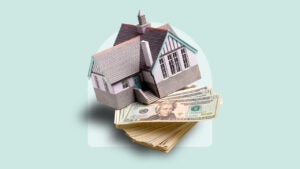Slight gains for home equity rates, holding near 2025 lows

Home equity rates nudged modestly higher in the latest week, sticking close to their lows of the year. The $30,000 home equity line of credit rose one basis point to 7.89 percent, according to Bankrate’s national survey of lenders. The benchmark 5-year $30,000 home equity loan rose two basis points, to 8.21 percent.
Even with this week’s modest gains, Jeff DerGurahian, head economist at loanDepot, notes that rising home values have pushed equity to record highs, giving homeowners more borrowing power and flexibility. “Equity products typically carry rates far below other forms of unsecured debt, such as credit cards and personal loans,” he says. “That combination makes home equity products a smart financial option for consolidating high-interest debt or covering large expenses like home improvements, college tuition or medical bills.“
| Current | 4 weeks ago | One year ago | 52-week average | 52-week low | |
|---|---|---|---|---|---|
| HELOC | 7.89% | 8.90% | 8.94% | 8.28% | 7.88% |
| 5-year home equity loan | 8.21% | 8.22% | 8.37% | 8.34% | 8.19% |
| 10-year home equity loan | 8.36% | 8.37% | 8.47% | 8.48% | 8.34% |
| 15-year home equity loan | 8.24% | 8.24% | 8.38% | 8.40% | 8.21% |
| Note: The home equity rates in this survey assume a line or loan amount of $30,000. | |||||
What’s driving home equity rates today?
Both HELOC and home equity loan rates have declined substantially from their 2024 highs and are near their lows of the year. Rates are being driven primarily by two factors — the first one is the Federal Reserve’s actions. In particular, the Fed impacts the cost of variable-rate products, like HELOCs. After cutting rates by a quarter point at its September meeting, the central bank suggested it may lower borrowing costs two more times this year.
“Homeowners considering a HELOC should be prepared for their rate to change shortly after each Fed decision,” says Stephen Kates, senior analyst at Bankrate. “Those considering a fixed-rate loan, on the other hand, should monitor rate trends closely to time their application for the best available offer, which may lag slightly behind Fed actions.”
Add to that lender competition, promotional offers and underwriting standards, all of which also have an impact on HELOC and home equity loan rates, says Kates. But beyond rates, “Some banks offer additional perks or services that may benefit borrowers,” he says. “Shopping around and comparing multiple offers is the best way to secure a competitive rate and find a banking relationship that aligns with your financial goals.”
Current home equity rates vs. rates on other types of credit
Because HELOCs and home equity loans use your home as collateral, their rates tend to be much less expensive — more akin to current mortgage rates — than the interest charged on credit cards or personal loans, which aren’t secured.
| Credit type | Average rate |
|---|---|
| HELOC | 7.89% |
| Home equity loan | 8.21% |
| Credit card | 20.09% |
| Personal loan | 12.27% |
|
Source: Bankrate national survey of lenders, Oct. 1 | |
While average rates are useful to know, the individual offer you receive on a particular HELOC or new home equity loan reflects additional factors like your creditworthiness and financials. Then there’s the value of your home and the size of your ownership stake. Lenders generally limit all your home loans (including your mortgage) to a maximum 80 to 85 percent of your home’s worth.
Keep in mind: Even if you’re able to secure a favorable rate from a lender, home equity products are still relatively high-cost debt.

Unlock your home’s value
A fixed-rate home equity loan offers a lump-sum payout and a predictable repayment schedule.
Explore offersOn average, mortgage-holding homeowners’ equity stakes have risen 142% nationwide since 2020, according to a Bankrate study on states with the most and least home equity gains.
Outstanding mortgages that were seriously underwater totalled 2.7% in Q2 2025, up from 2.4% in Q2 2024, according to ATTOM Data Solutions.
The average homeowner lost about $9,200 in equity in the past year, leaving them with about $307,000 in equity, according to Cotality.
Borrowers withdrew 0.45% of their tappable equity at the start of the second quarter, the highest overall equity extraction rate since late 2022, according to ICE Mortgage Technology.
Why we ask for feedback Your feedback helps us improve our content and services. It takes less than a minute to complete.
Your responses are anonymous and will only be used for improving our website.
You may also like

Lenders love fixed-rate HELOCs. Should you?

HELOC and home equity loan requirements in 2025

Small moves for home equity rates this week

What is the draw period on a HELOC?


